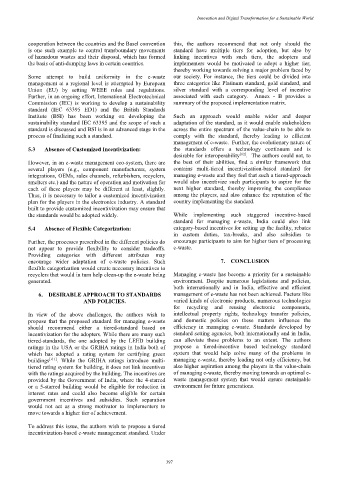Page 441 - Kaleidoscope Academic Conference Proceedings 2024
P. 441
Innovation and Digital Transformation for a Sustainable World
cooperation between the countries and the Basel convention this, the authors recommend that not only should the
is one such example to control transboundary movements standard have multiple tiers for adoption, but also by
of hazardous wastes and their disposal, which has formed linking incentives with such tiers, the adopters and
the basis of anti-dumping laws in certain countries. implementers would be motivated to adopt a higher tier,
thereby working towards solving a major problem faced by
Some attempt to build uniformity in the e-waste our society. For instance, the tiers could be divided into
management at a regional level is attempted by European three categories like Platinum standard, gold standard, and
Union (EU) by setting WEEE rules and regulations. silver standard with a corresponding level of incentive
Further, in an ongoing effort, International Electrotechnical associated with each category. Annex - B provides a
Commission (IEC) is working to develop a sustainability summary of the proposed implementation matrix.
standard (IEC 63395 ED1) and the British Standards
Institute (BSI) has been working on developing the Such an approach would enable wider and deeper
sustainability standard IEC 63395 and the scope of such a adaptation of the standard, as it would enable stakeholders
standard is discussed and BSI is in an advanced stage in the across the entire spectrum of the value-chain to be able to
process of finalizing such a standard. comply with the standard, thereby leading to efficient
management of e-waste. Further, the evolutionary nature of
5.3 Absence of Customized Incentivization: the standards offers a technology continuum and is
desirable for interoperability [62] . The authors could not, to
However, in an e-waste management eco-system, there are the best of their abilities, find a similar framework that
several players (e.g., component manufacturers, system contains multi-tiered incentivization-based standard for
integrations, OEMs, sales channels, refurbishers, recyclers, managing e-waste and they feel that such a tiered-approach
smelters etc.) and the nature of operation and motivation for would also incentivize such participants to aspire for the
each of these players may be different at least, slightly. next higher standard, thereby improving the compliance
Thus, it is necessary to tailor a customized incentivization among the players, and also enhance the reputation of the
plan for the players in the electronics industry. A standard country implementing the standard.
built to provide customized incentivization may ensure that
the standards would be adopted widely. While implementing such staggered incentive-based
standard for managing e-waste, India could also link
5.4 Absence of Flexible Categorization: category-based incentives for setting up the facility, rebates
in custom duties, tax-breaks, and also subsidies to
Further, the processes prescribed in the different policies do encourage participants to aim for higher tiers of processing
not appear to provide flexibility to consider tradeoffs. e-waste.
Providing categories with different attributes may
encourage wider adaptation of e-waste policies. Such 7. CONCLUSION
flexible categorization would create necessary incentives to
recyclers that would in turn help clean-up the e-waste being Managing e-waste has become a priority for a sustainable
generated. environment. Despite numerous legislations and policies,
both internationally and in India, effective and efficient
6. DESIRABLE APPROACH TO STANDARDS management of e-waste has not been achieved. Factors like
AND POLICIES. varied kinds of electronic products, numerous technologies
for recycling and reusing electronic components,
In view of the above challenges, the authors wish to intellectual property rights, technology transfer policies,
propose that the proposed standard for managing e-waste and domestic policies on these matters influence the
should recommend either a tiered-standard based on efficiency in managing e-waste. Standards developed by
incentivization for the adopters. While there are many such standard setting agencies, both internationally and in India,
tiered-standards, the one adopted by the LEED building can alleviate these problems to an extent. The authors
ratings in the USA or the GRIHA ratings in India both of propose a tiered-incentive based technology standard
which has adopted a rating system for certifying green system that would help solve many of the problems in
buildings [ 61] . While the GRIHA ratings introduce multi- managing e-waste, thereby leading not only efficiency, but
tiered rating system for building, it does not link incentives also higher aspiration among the players in the value-chain
with the ratings acquired by the building. The incentives are of managing e-waste, thereby moving towards an optimal e-
provided by the Government of India, where the 4-starred waste management system that would ensure sustainable
or a 5-starred building would be eligible for reduction in environment for future generations.
interest rates and could also become eligible for certain
government incentives and subsidies. Such separation
would not act as a strong motivator to implementers to
move towards a higher tier of achievement.
To address this issue, the authors wish to propose a tiered
incentivization-based e-waste management standard. Under
– 397 –

